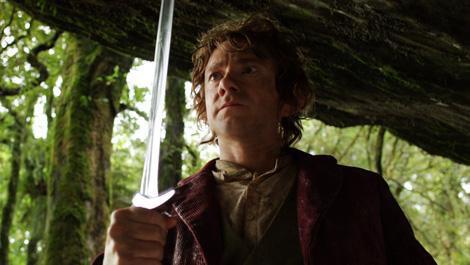Unless you have been living in a cave, you probably know that Peter Jackson’s new mega-opus The Hobbit hits American screens very soon. You probably already know a couple other things about the project:
- This is the first film of a trilogy, which is odd because the original book is only about 300 pages long.
- It was filmed in HFR, aka High Frame Rate, which means it runs at 48 frames per second instead of the normal 24.
- It was also filmed in 3D.
No, I have not already seen The Hobbit: An Unexpected Journey, though a few critics have already seen the film and their mixed reviews are starting to hit the Internet. I try not to hate upon a film I have not yet seen, and that is not my intent in this post. Instead, I just want to jot down a few thoughts I’ve been mulling over, here on the eve of viewing a shiny new piece of cinema technology.
First of all, I’ve heard people ask what format they should see the film in. I’m a big believer in seeing a film in its original format. If it was filmed in 3D, see it in 3D. If it was filmed in 48fps, see it in 48fps. If it was filmed in IMAX, see it in real IMAX (not in Digital IMAX, mind you). The Hobbit was filmed in 3D at 48fps, so I have every intent of seeing it in that format.
That said, 48fps is a rather jarring leap of technology. If you are a passive filmgoer and you don’t really care about HFR and just want to see dwarfs and wizards and stuff, I hear that the 24fps conversion is pretty good. The conversion adds motion blur between the frames, so it should reduce the judder you normally see in digital-to-film conversions.
Why am I hedging my bets on 48fps? I’m usually all for new technology, and I haven’t even seen HFR in action. What gives? Here are my concerns:
- By all reports, HFR looks very, very different from what we expect from a film. It seems that many critics are finding this distracting. My guess is that the public will be even less forgiving.
- Nobody knows how to direct movies in HFR yet. The Hobbit is a great big experiment. Directing a 3D film is different from directing a 2D film; directing a color film is different from directing a black-and-white film; directing a silent film is different from directing a sound film. HFR is no different. It will take time for directors to figure out how to best craft an HFR film so it tells a story without jarring the viewer.
- HFR hides nothing. Special effects of all kinds — CGI, makeup, matte paintings, whatever — all rely to some degree on sleight-of-hand. Many movies benefit from having a sort of thin veil between the audience and the movie magic, whether it’s the black-and-white cinematography of 1933’s King Kong or the heavy film grain of Minority Report. The Hobbit is being filmed in high-definition 3D digital HFR. That’s like trying to do a magic trick in a hall full of mirrors and video cameras.
In a nutshell, I don’t have anything in particular against HFR, but I suspect that putting HFR and The Hobbit together may be a poor marriage of story and format. A better introduction of HFR probably should have looked like the early introduction of IMAX filmmaking: documentaries tailored to be immersive experiences. Making The Hobbit into a massive trilogy was already a tall order; positioning it as the vanguard of a new cinematic technology may be one burden too many.
It’s doubly worrisome that this choice came out of Peter Jackson and Weta Studios, who in the past have made truly wise decisions in marrying low-tech with high-tech.
I’d love to see HFR work out. I think there is potential in the technology to make truly extraordinary cinematic experiences. I’d also love to see The Hobbit work out. I hope my concerns are for naught, and that I have a truly grand time watching the film.





